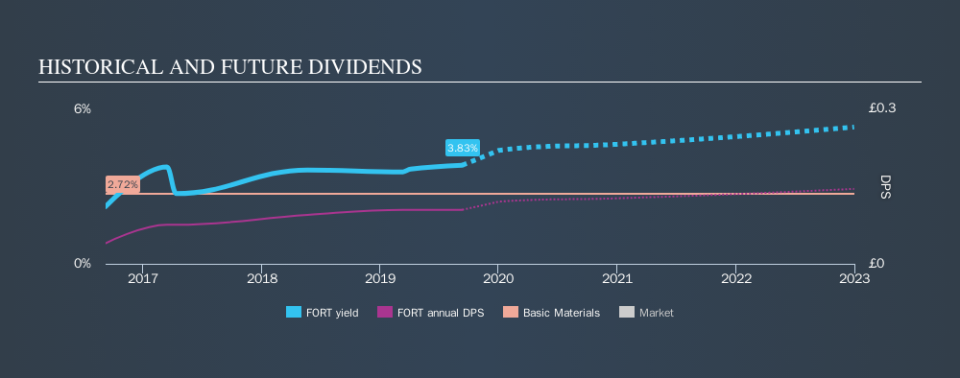Read This Before Buying Forterra plc (LON:FORT) For Its Dividend

Dividend paying stocks like Forterra plc (LON:FORT) tend to be popular with investors, and for good reason - some research suggests a significant amount of all stock market returns come from reinvested dividends. If you are hoping to live on your dividends, it's important to be more stringent with your investments than the average punter. Regular readers know we like to apply the same approach to each dividend stock, and we hope you'll find our analysis useful.
Forterra yields a solid 3.8%, although it has only been paying for three years. A high yield probably looks enticing, but investors are likely wondering about the short payment history. The company also bought back stock during the year, equivalent to approximately 2.1% of the company's market capitalisation at the time. There are a few simple ways to reduce the risks of buying Forterra for its dividend, and we'll go through these below.
Explore this interactive chart for our latest analysis on Forterra!
Payout ratios
Companies (usually) pay dividends out of their earnings. If a company is paying more than it earns, the dividend might have to be cut. As a result, we should always investigate whether a company can afford its dividend, measured as a percentage of a company's net income after tax. Forterra paid out 41% of its profit as dividends, over the trailing twelve month period. This is a middling range that strikes a nice balance between paying dividends to shareholders, and retaining enough earnings to invest in future growth. Plus, there is room to increase the payout ratio over time.
Another important check we do is to see if the free cash flow generated is sufficient to pay the dividend. Forterra's cash payout ratio in the last year was 38%, which suggests dividends were well covered by cash generated by the business. It's encouraging to see that the dividend is covered by both profit and cash flow. This generally suggests the dividend is sustainable, as long as earnings don't drop precipitously.
Consider getting our latest analysis on Forterra's financial position here.
Dividend Volatility
One of the major risks of relying on dividend income, is the potential for a company to struggle financially and cut its dividend. Not only is your income cut, but the value of your investment declines as well - nasty. The company has been paying a stable dividend for a few years now, but we'd like to see more evidence of consistency over a longer period. During the past three-year period, the first annual payment was UK£0.04 in 2016, compared to UK£0.10 last year. Dividends per share have grown at approximately 38% per year over this time.
Forterra has been growing its dividend quite rapidly, which is exciting. However, the short payment history makes us question whether this performance will persist across a full market cycle.
Dividend Growth Potential
While dividend payments have been relatively reliable, it would also be nice if earnings per share (EPS) were growing, as this is essential to maintaining the dividend's purchasing power over the long term. Forterra's EPS have fallen by approximately 89% per year. With this kind of significant decline, we always wonder what has changed in the business. Dividends are about stability, and Forterra's earnings per share, which support the dividend, have been anything but stable.
Conclusion
To summarise, shareholders should always check that Forterra's dividends are affordable, that its dividend payments are relatively stable, and that it has decent prospects for growing its earnings and dividend. Firstly, we like that Forterra has low and conservative payout ratios. Unfortunately, there hasn't been any earnings growth, and the company's dividend history has been too short for us to evaluate the consistency of the dividend. In sum, we find it hard to get excited about Forterra from a dividend perspective. It's not that we think it's a bad business; just that there are other companies that perform better on these criteria.
Given that earnings are not growing, the dividend does not look nearly so attractive. Businesses can change though, and we think it would make sense to see what analysts are forecasting for the company.
If you are a dividend investor, you might also want to look at our curated list of dividend stocks yielding above 3%.
We aim to bring you long-term focused research analysis driven by fundamental data. Note that our analysis may not factor in the latest price-sensitive company announcements or qualitative material.
If you spot an error that warrants correction, please contact the editor at editorial-team@simplywallst.com. This article by Simply Wall St is general in nature. It does not constitute a recommendation to buy or sell any stock, and does not take account of your objectives, or your financial situation. Simply Wall St has no position in the stocks mentioned. Thank you for reading.

